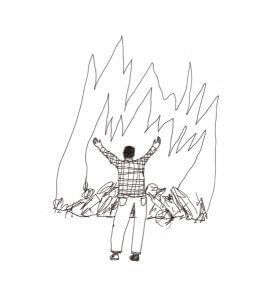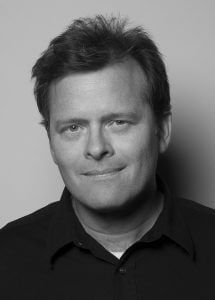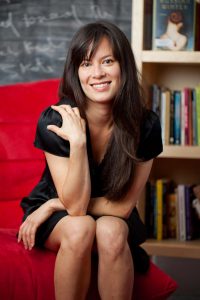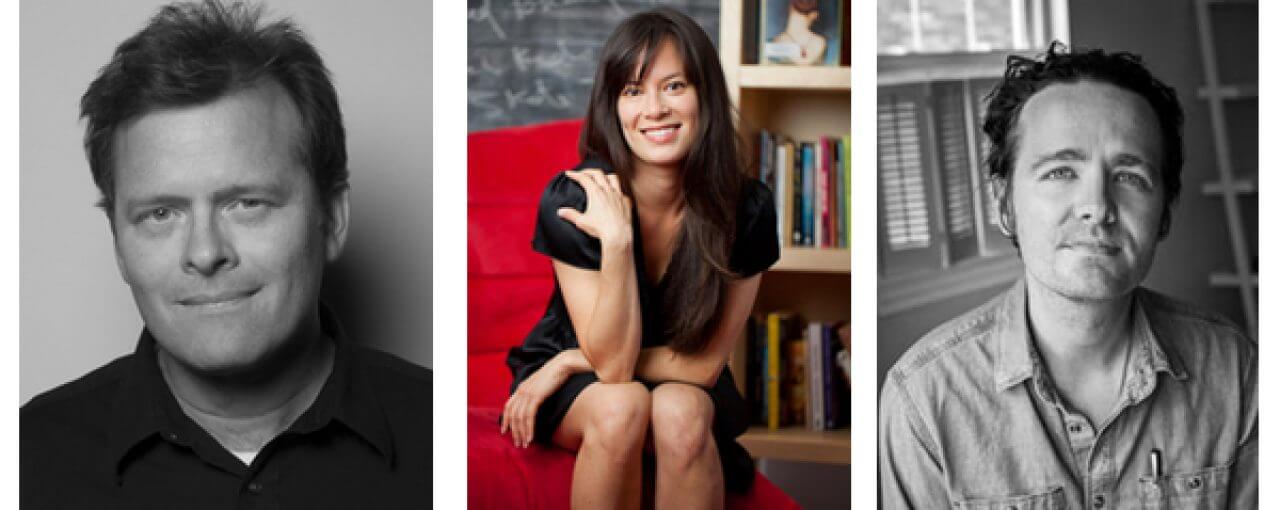November 2018
By DeWitt Henry, Literary Bookmarks Editor
Monthly link highlights to online resources, magazines, and author sites that seem informative and inspiring for working writers. Most are free. Suggestions are welcomed.
Ryan Ridge: Fiction Writer, Poet, Editor

Ridge’s site looks offhanded and simplistic at first. “Home” offers a cartoonish line sketch of the back of a man with arms raised toward what could be flames or mountains (actually it’s flames, an illustration from a chapter in Second Acts in American Lives that refers to a bonfire of Bibles); below this, Ridge offers his witty Twitter feed. He is seriously unserious. “About” is the sixth tab, featuring his photo and biography. In straightforward summary, we learn that he has four books, and that a new collection of stories, New Bad News, the 2018 Bruckheimer Selection, will be out in 2020 from Sarabande Books. He has previously received the Italo Calvino Prize in Fabulist Fiction for the hybrid novel American Homes (U of MI, 2015). He co-directs the Creative Writing Program at Weber State University in Ogden, UT, and edits the literary magazine Juked. The other tabs are for “Books,” “Events,” “Press” and “Blog,” and provide an expanded gallery of his sensibility, as Juked itself does.
“Events” consists of posters and fliers that track his billings for readings, intros, and symposia from the present back to 2011. The visuals are Monty Pythonesque, and the company around the country impressive: William Kittredge, Karl Taro Greenfield, Andrew Tonkovich, Kate Durbin, Ashley Farmer, Kathy Fish, Anthony Doerr, Mark Drew, and others. “Press” consists of reviews of his books and of interviews with Ridge, where he speaks of his collaboration with Mel Bosworth in their flash fiction collection, Second Acts in American Lives (Alternating Current, 2018): “I stop. He finishes, then gives me a start to finish on another story.” Or again: “Some writers aspire for timelessness, but I’d settle for timeliness.” He cites Ander Monson of Diagram and Dave Eggers of McSweeney’s as editorial inspirations. He also admires Hunter S. Thompson, Richard Brautigan, and David Markson as writers. The most unusual interview is a collaboration, where first he interviews his writer wife, Ashley Farmer; then she interviews him. Finally, under the “Blog” tab is an archive of entries dating back to 2012, and searchable by such categories as: “All…21st Century…Anthony Kiedis…Art…Drawings…Hunter S. Thompson…Moon Landing…New News…UFOs.” Most entries are Marksonesque one-liners, such as “News Kept Breaking And No One Could Fix It.”
Together with inventiveness and wit, Ridge’s complaint is more biting than winsome, and earns attention. One of my favorite lines from Second Acts (the title comes from Fitzgerald’s: “There are no second acts in American lives”): “we wanted to wake up into a world that wasn’t shot.” I also recommend “Five Deaths,” which appeared recently in SleazeMag. Here Ridge personifies Death as an ordinary, contemporary one-of-us and ends with a long list of dead ideas and things: “Irony is dead. / Modernism is dead. / Postmodernism is dead. / …The novel is dead. / The fedora is dead. /
…And on and on until the end when everything is dead including the sun. / Death is dead, too, of course, but checking himself out in the mirror just now with his shirt off and his pecs flexed, he thinks: Damn, I look alive!”
David Blair: Poet and Essayist

Blair has an assured voice, an appetite for life, and remarkable formal and thematic range. My first thought on hearing him read poems set in the Bronx was of Hubert Selby’s Last Exit To Brooklyn; then of Thomas Lux and Bill Knott, and their love of colloquial phrases and high velocity wit; then of Charlie Chaplin. I read Blair’s third collection, Friends With Dogs (Sheep Meadow, 2016), and then explored the riches of his well-designed web page, which, besides offering a substantial gallery of published, representative work both in poetry and prose, includes this bio:
David Blair grew up in Pittsburgh. He is the author of three books of poetry, Ascension Days, which was chosen by Thomas Lux for the Del Sol Poetry Prize, Arsonville, and Friends with Dogs.… He has taught at the New England Institute of Art, Bentley University, the online graduate program at Southern New Hampshire University, and in the M.FA. Writing Program at the University of New Hampshire. He lives in Somerville, Massachusetts, with his wife and daughter, and he has a degree in philosophy from Fordham University and an M.F.A. in creative writing from the University of North Carolina at Greensboro. In 2019, MadHat Press will publish his fourth book of poetry, Barbarian Seasons, and his first collection of essays, Walk Around: Essays about Poetry and Place.
Another tab offers paragraphs of praise from the likes of Stephen Burt (“a really simple language that can helix itself around [anything]”), David Ferry (“sympathetic pathos”), Thomas Lux (“his refusal to use [ever!] cliches”), and Tom Sleigh (“a Hardyish sense of regret and loss”), and Tony Hoagland (“clear-eyed and street savvy impressionism”). Full reviews of his books are found under the “Prose” tab, along with Blair’s own reviews of others. Under “Media,” I recommend his interview by Doug Holder, where he speaks about walking, the beauty of ugliness, and technical issues of craft.
But the site’s payload is the selection of thirty poems reprinted from periodicals. Blair’s favored mode is that of surreal, hypercharged metaphor (think of James Tate on “dead-end metaphor” and Robert Pinsky’s 1992 warning about this mode resulting in new cliches in Poetry and the World). For instance: “Her house is a courageous hairdo, a curl / constructed entirely of brown, fibrous light” (“Amelia Earhart”) or “The big, red kangaroos were dreamily peed on / by the less abstract brown ones” (“Free Variation from Ovid’s Amores”). Compare his more straight-forward mode: “Graduations are risen like fire flies from grasses / in the smoke of backyards and embankments” (“Graduation Poem”) or “My parents’ house took a beating / the winter my mother was going— / blizzards, ice busted gutters, / the wallpaper stained with run-off” (“Poem about Pittsburgh Houses”). As Hoagland observes, “This is poetry owned by no aesthetic party or posse, yet which somehow includes them all.”
Sonya Larson: Fiction and Nonfiction writer

Larson is an “emerging” fiction writer with remarkable insight, craft, and range, and also with a gift for going all the way with her stories, and then some. Her website serves to introduce her accomplishments and promise—an early career widely recognized by periodical publications, grants, honors and fellowships. She has no book yet, but is developing a profile and fan base.
From the “About” tab, we learn that “she currently works as Director of the Muse and the Marketplace literary conference, hosted by GrubStreet in Boston, as well as Director of GrubStreet’s race and advocacy work. She received her MFA in fiction in the Program for Writers at Warren Wilson College. Sonya lives in Somerville, MA, and is currently writing a novel.” With thirteen published stories she clearly also has enough for a first collection. (Is the novel about the Chinese-American young woman, Chuntao, who is featured in two of her recent stories, I wonder? Elsewhere, an article notes that “She is at work on a novel about a Chinese community living in rural Mississippi in the 1930s.”)
Ten of the stories (under the “Fiction and Nonfiction” tab) are hotlinked and available online. These include “Q County Colored Penitentiary,” Memorious, Fall 2017; “God Is Love is Love is Love,” American Literary Review, Spring 2016, and exclude others in magazines that don’t freely share their archives, such as “Gabe Love,” Salamander, #43 (also reprinted in Best American Short Stories 2018). They exclude “The Kindest,” American Short Fiction, 2016, a major story; however, “The Kindest” is described and paraphrased in detail on the Ploughshares blog.
While Larson writes effective micro stories, such as “The Request,” “The Peak,” and “AA,” all in Solstice: A Magazine of Diverse Voices, June 2018, her longer stories are her most masterful and stunning. “Q County Colored Penitentiary” addresses the world and manner of Faulkner’s The Sound and the Fury and the doomed racist dream of dynasties of the 1890s to 1940s. My favorite story so far, “God is Love is Love is Love,” recalls and surpasses Ann Beattie’s “The Cinderella Waltz,” which offered a baffled wife’s point of view, having been left by her gay husband for another man. Larson’s story is from a gay ex-husband’s point of view as he tries, together with his lover, to keep a strong relationship with his young daughter; Larson also focuses powerfully on religious intolerance, with the wife and her priest trying to convince the daughter that gays can’t go to heaven.
“I write about racism,” she says in an interview (under the “Media and Interviews” tab); “how it inflects our most intimate feelings, relations, and the stories we tell ourselves.”
She wants her writing to be “a Rorschach test—to reveal our perception of a thing.” She seeks to create “layers of myopia, guilelessness, and a thing I call ‘narrational control.’” This last term is also the subject of her Baxteresque craft essay, “Catch and Release: Strategies of Overt and Covert Narratorial Control,” The Writer’s Chronicle, March 2018.
Finally, under a tab-in-progress, “On Race,” she promises to discuss “essays, books, and teachings re: Race + Writing that I admire.” I look forward, in all regards.
Copyright 2018 Woven Tale Press LLC. All Rights Reserved.

